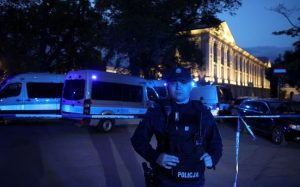South African authorities have launched a manhunt for an alleged “kingpin” connected to an illegal mining operation at an abandoned gold mine, where 78 bodies were discovered last week. The individual, James Neo Tshoaeli, a Lesotho national also known as “Tiger,” is accused of masterminding the illegal mining activities at the site in Stilfontein, a town situated about 145 kilometers (90 miles) southwest of Johannesburg. According to the police, Tshoaeli is also believed to have orchestrated his own escape with the help of officials after being pulled from the mine during the rescue operation.
More than 240 miners were successfully rescued from the site after being trapped underground for months. Prior to the rescue, the mine had been blockaded by police in an attempt to force the miners to surface. The authorities had cut off food and water supplies in a high-stakes effort to pressure the miners into surrendering. In the dark, cramped tunnels, many miners had been exposed to horrific conditions, including decaying bodies and extreme deprivation. While the survivors were brought to the surface, many of them were weak and emaciated, showing signs of significant malnutrition.
Police reports revealed that some of the miners who had been trapped underground accused Tshoaeli of causing immense suffering, including being responsible for deaths, assaults, and torture within the mine. One of the most disturbing claims was that Tshoaeli had hoarded food supplies, keeping it from the other miners and allowing them to suffer as a result. This compounded the already brutal conditions that the miners had to endure.
In a statement issued by police, South Africa’s top law enforcement official, Commissioner Patrick Asaneng, made it clear that heads would roll once the individuals responsible for helping Tshoaeli escape were found. The police force expressed disappointment and embarrassment over the escape, with police spokesperson Athlenda Mathe admitting the situation had tarnished the police’s reputation. Mathe confirmed that an internal investigation was underway and that the probe would begin by looking into possible corruption within the force, especially among those who might have facilitated Tshoaeli’s flight.
Tshoaeli’s escape came shortly after a months-long blockade of the mine shaft. The situation escalated to a legal standoff, with a court ruling that the government must facilitate the rescue of the miners. On Thursday, as the operation concluded, Mathe noted that the identification of the 78 recovered bodies would be a monumental task, in part because many of the victims were undocumented migrants, which added a layer of complexity to the identification process.
The miners had been trapped since November of the previous year, when the police initiated a nationwide crackdown on illegal mining operations, which are rampant in South Africa. The country has long struggled with the issue of illegal mining, with thousands of individuals, known as “zama zamas” (which translates to “those who try their luck” in Zulu), operating in the country’s mineral-rich mines. These miners often risk their lives working under dangerous and exploitative conditions, often controlled by powerful criminal syndicates that profit from the illicit trade.
The mine in Stilfontein, which has since been cleared of both bodies and survivors, remains a symbol of the grave dangers associated with illegal mining in South Africa. The government and police have defended their actions during the blockade and rescue operation, insisting that they were dealing with a significant criminal operation. The authorities argue that the real culprits behind the situation are the kingpins of illicit mining syndicates like Tshoaeli, who exert control over the miners and the distribution of supplies. These individuals are also said to have been preventing miners from leaving the shafts, further exacerbating the deadly conditions.
However, the authorities’ actions have not gone without criticism. Trade unions and human rights organizations have accused the police of causing a “massacre” by not doing more to protect the miners. These groups argue that the authorities should have prioritized the safety and well-being of the individuals trapped underground, rather than focusing primarily on eradicating illegal mining and its criminal elements.
While the police face scrutiny over their methods, the complex dynamics of illegal mining in South Africa—where economic desperation meets organized crime—pose significant challenges to law enforcement and the mining industry alike. In the wake of this tragedy, both the government and the public must confront the ongoing issue of illegal mining and its human cost. The manhunt for Tshoaeli is ongoing, and authorities have vowed to bring him to justice for his alleged role in the deadly events that unfolded in Stilfontein.






